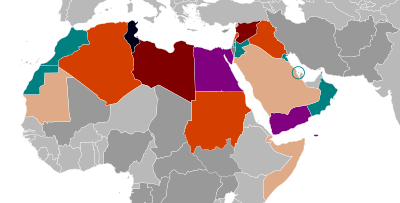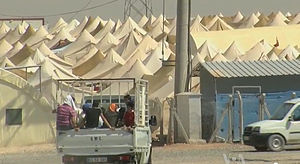Arab Winter
| Arab Winter | |
|---|---|
| Part of the aftermath of the Arab Spring and the War on terror | |
 | |
| Date | Mid-2012 to roughly 2019 (~7 years) (ongoing in some countries) |
| Location | |
| Caused by | |
| Goals | |
| Methods | |
| Resulted in |
|
The Arab Winter[1][2][3][4][5] (Arabic: الشتاء العربي, romanized: ash-shitāʼ al-ʻarabī) is a term referring to the resurgence of authoritarianism and Islamic extremism[6] in some Arab countries in the 2010s in the aftermath of the Arab Spring.[7] The term "Arab Winter" refers to the events across Arab League countries in the Middle East and North Africa, including the Syrian civil war,[8][9] the Iraqi insurgency and subsequent war in Iraq,[10] the Egyptian Crisis,[11] the Libyan crisis, and the Yemeni crisis including the Yemeni civil war.[12]
The term was first coined by Chinese political scientist Zhang Weiwei during a debate with American political scientist Francis Fukuyama on 27 June 2011. Fukuyama believed the Arab Spring movement would spread to China, while Zhang predicted the Arab Spring would soon turn into an Arab Winter.[13][14]
According to scholars of the University of Warsaw, the Arab Spring fully devolved into the Arab Winter four years after its onset, in 2014.[15] The Arab Winter is characterized by the emergence of multiple regional wars, mounting regional instability,[16] economic and demographic decline of Arab countries,[17] and ethno-religious sectarian strife.[18] According to a study by the American University of Beirut, by the summer of 2014, the Arab Winter had resulted in nearly a quarter of a million deaths and millions of refugees.[19] Perhaps the most significant event of the Arab Winter was the rise of the Islamic State, which controlled swathes of land in the region from 2014 to 2019.[20]
In 2025, multiple armed conflicts are still continuing that might be seen as a result of the Arab Spring. The Syrian civil war has caused massive political instability and economic hardship in Syria, with the Syrian currency plunging to new lows.[21] In Yemen, a civil war and subsequent intervention by Saudi Arabia continues to affect the country.[22]
Definition
[edit]The term Arab Winter typically includes the following events:
| Country | Event | Start year |
|---|---|---|
| Syria | Syrian civil war | 2011 |
| Iraq | Iraqi insurgency (2011–2013) | 2011 |
| War in Iraq (2013–2017) | 2013 | |
| Egypt | Egyptian Crisis (2011–2014) | 2011 |
| 2013 Egyptian coup d'état | 2013 | |
| Libya | First Libyan Civil War | 2011 |
| Second Libyan Civil War | 2014 | |
| Yemen | Yemeni civil war (2014–present) | 2014 |
| Lebanon | Syrian civil war spillover in Lebanon | 2011 |
| Bahrain | 2011 Bahraini uprising | 2011 |
| Tunisia | 2021 Tunisian self-coup | 2021 |
Geography
[edit]
The term "Arab Winter" refers to the events across Arab League countries in the Middle East and North Africa, including the Syrian civil war,[8][9] the Iraqi insurgency and the subsequent War in Iraq,[10] the Egyptian Crisis,[11] the First Libyan Civil War and the subsequent Second Libyan Civil War, and the Yemeni civil war.[12] Events referred to as the Arab Winter include those in Egypt that led to the removal from office in 2013 of Mohamed Morsi and the subsequent election in 2014 of Abdel Fattah el-Sisi.[23]
Political developments, particularly the restoration of authoritarianism and suppression of civil liberties in Egypt since 3 July 2013, have been described as constituting a "military winter" that functioned in opposition to the goals of the Arab Spring.[24][25] Various militias and tribes have started fighting in Libya after a breakdown in negotiations.[26] The arenas of Lebanon and Bahrain were also identified as areas of the Arab Winter.[17]
Libya was named as a scene of the Arab Winter, together with Syria, by Professor Sean Yom.[26] The Northern Mali conflict was often described as part of the "Islamist Winter".[27] Political changes which occurred in Tunisia, involving a change in government, as well as an ISIL insurgency, were also indicated by some as a possible "heading towards Arab Winter".[23][clarification needed]
Beginning date
[edit]The first cases of usage of the Arab Winter term can be found since 1 February 2011.
Then, the Arab Winter term began circulating in the media in late 2012 and getting popular since then, referring to the deterioration of many Arab Spring conflicts into prolonging and escalating events of sectarian strife and armed violence. In its December 2012 publication, The Daily Telegraph referred to the year 2012 as the year of Arab Winter.[1]
According to scholars of the University of Warsaw, the Arab Spring fully devolved into the Arab Winter four years after its onset.[28] This view was also supported by Prof. James Y. Simms Jr. in his 2015 opinion article for the Richmond Times-Dispatch.[29] In early 2016, The Economist marked the situation across Arab world countries as "worse than ever", marking it as the ongoing Arab Winter.[30]
Impact
[edit]Economic impact
[edit]According to the Moshe Dayan Center for Middle Eastern and African Studies, as of January 2014, the cost of Arab Winter upheaval across the Arab World was some $800 billion USD.[17] Some 16 million people in Syria, Egypt, Iraq, Jordan and Lebanon were expected to require humanitarian assistance in 2014.[17]
According to The Economist, Malta has "benefitted" from the Arab Winter, as tourists who might otherwise be in Egypt or Tunisia opt for a safer alternative.[31]
Casualties
[edit]According to a study by the American University of Beirut, as of the summer of 2014, the Arab Winter had resulted in nearly a quarter of a million deaths and millions of refugees.[19]
Political columnist and commentator George Will reported that as of early 2017, over 30,000 lives had been lost in Libya, 220,000–320,000 had been killed in Syria and 4 million refugees had been produced by the Syrian Civil War alone.[29]
The Arab Winter is still ongoing as of 2021. Casualties per crisis include:
- Syrian civil war – casualty figure at 570,000 killed and counting – Conflict ongoing
- 2011 Iraqi insurgency, 2013 civil war, and subsequent Islamic State insurgency – casualty figure at 220,000+ killed and counting – Civil war declared over in 2017, insurgency ongoing
- Yemeni civil war – casualty figure at 350,000+ killed and counting[32] – Conflict ongoing
- Libyan Crisis – casualty figure 40,000+ killed and counting – Conflict ongoing
- Egyptian Crisis and Sinai insurgency – marked the start of the Arab winter, casualty figure 5,000+ killed and counting – Conflict declared over in 2023, sporadic attacks continue
Migrant crisis
[edit]
The political turmoil and violence in the Middle East and North Africa resulted in massive population displacement in the region.[33] As a result, "boat people", which was once commonly referred to Vietnamese boat people, became frequently used, including internally displaced persons and asylum-seekers and refugees who had previously been residing in Libya, Syria, and Iraq have headed towards the European Union.[34]
The attempts by some Libyans, Syrians and Tunisians to seek safety from the violence by crossing the Mediterranean sea have triggered fears among European politicians and populations of arrivals that might "flood" their shores. This has spurred a flurry of legislative activity and patrolling of the waters to manage arrivals.[34] Despite recent efforts at a common approach to migration by the European Union Hungary and Poland have not been convinced yet.[35] Monetary support authorised by the German legislature for private rescue operations at sea have triggered Italian government animosity.[36][37][38]
See also
[edit]- List of modern conflicts in North Africa
- Spillover of the Syrian Civil War
- Iran–Saudi Arabia proxy conflict
- Second Arab Spring
- Lampedusa
References
[edit]- ^ a b Spencer, Richard (31 December 2012). "Middle East review of 2012: the Arab Winter". The Telegraph. Archived from the original on 10 June 2019. Retrieved 19 July 2014.
- ^ "Analysis: Arab Winter is coming to Baghdad". The Telegraph. The Jerusalem Post. 15 June 2014. Archived from the original on 14 July 2019. Retrieved 8 October 2014.
- ^ "Expert Warns of America's Coming 'Arab Winter'". CBN. 8 September 2014. Archived from the original on 9 December 2018. Retrieved 8 October 2014.
- ^ "The Arab Winter". The New Yorker. 28 December 2011. Archived from the original on 25 September 2018. Retrieved 8 October 2014.
- ^ "Arab Spring or Arab Winter?". The New Yorker. Archived from the original on 18 July 2019. Retrieved 8 October 2014.
- ^ Yun Ru Phua (31 March 2015). "After Every Winter Comes Spring: Tunisia's Democratic Flowering – Berkeley Political Review". Bpr.berkeley.edu. Archived from the original on 29 July 2017. Retrieved 11 February 2017.
- ^ Ahmed H Adam and Ashley D Robinson. Will the Arab Winter spring again in Sudan?. Al-Jazeera. 11 June 2016. [1] Archived 8 February 2018 at the Wayback Machine "The Arab Spring that swept across the Middle East and succeeded in overthrowing three dictatorships in Tunisia, Egypt and Libya in 2011 was a pivotal point in the history of nations. Despite the subsequent descent into the "Arab Winter", the peaceful protests of young people were heroic..."
- ^ a b Karber, Phil (18 June 2012). Fear and Faith in Paradise. Rowman & Littlefield Publishers. ISBN 978-1-4422-1479-8. Archived from the original on 23 September 2023. Retrieved 23 October 2014.
- ^ a b "Arab Winter". America Staging. 28 December 2012. Archived from the original on 26 October 2014. Retrieved 23 October 2014.
- ^ a b "Analysis: Arab Winter is coming to Baghdad". The Jerusalem Post. 15 June 2014. Archived from the original on 14 July 2019. Retrieved 23 October 2014.
- ^ a b "Egypt and Tunisia's new 'Arab winter'". Euro news. 8 February 2013. Archived from the original on 29 June 2019. Retrieved 23 October 2014.
- ^ a b "Yemen's Arab winter". Middle East Eye. Archived from the original on 30 September 2018. Retrieved 23 October 2014.
- ^ Zhang, Weiwei (21 March 2012). China Wave, The: Rise Of A Civilizational State. World Century Publishing Corporation. p. 158. ISBN 978-1-938134-03-6. Archived from the original on 23 September 2023. Retrieved 5 September 2022.
My observation of the Middle East has led me to conclude that, while many in the West cheer the Arab Spring, one shouldn't be too optimistic. I hope the region will do well, but it will be difficult, and the Arab Spring today may well turn into an Arab Winter in a not-too-distant future with the American interest undermined.
- ^ Fukuyama, Francis; Weiwei, Zhang (2011). "The China Model: A Dialogue between Francis Fukuyama and Zhang Weiwei". New Perspectives Quarterly. 28 (4): 40–67. doi:10.1111/j.1540-5842.2011.01287.x. ISSN 1540-5842. Archived from the original on 14 June 2021. Retrieved 15 June 2021.
- ^ Fiedler, Radoslaw; Osiewicz, Przemyslaw (17 August 2015). Transformation processes in Egypt after 2011: The causes, their course and international response. Logos Verlag Berlin GmbH. p. 182. ISBN 978-3-8325-4049-4. Archived from the original on 23 September 2023. Retrieved 5 September 2022.
- ^ Wolff, Stefan (17 April 2014). "From Egypt to Syria, this could be the start of the Arab Winter". The Conversation. Archived from the original on 18 July 2019.
- ^ a b c d Rivlin, P (January 2014), Iqtisadi (PDF), Dayan Research Center, archived from the original (PDF) on 23 October 2014, retrieved 18 October 2014
- ^ Malmvig, Lassen (2013), Arab uprisings: regional implication (PDF), IEMED, archived from the original (PDF) on 24 September 2015, retrieved 18 October 2014
- ^ a b "Displacement in the Middle East and North Africa – between the Arab Winter and the Arab Spring" (PDF), International Affairs, LB, 28 August 2013, archived from the original (PDF) on 18 October 2014, retrieved 18 October 2014
- ^ Wilner, Michael (15 June 2014). "Analysis: Arab Winter is coming to Baghdad". The Jerusalem Post. Archived from the original on 14 July 2019. Retrieved 21 August 2018.
- ^ Chulov, Martin (12 June 2020). "US 'Caesar Act' sanctions could devastate Syria's flatlining economy". The Guardian. Archived from the original on 15 August 2022.
- ^ "Yemen's Government demands UN action regards Houthi violation of deal". Arab News. 12 June 2020. Archived from the original on 23 September 2023.
- ^ a b "Egypt & Tunisia's new Arab winter", Euro news, 8 February 2013, archived from the original on 29 June 2019, retrieved 18 October 2014
- ^ Hayden, Tom (5 July 2013). "The Coup in Egypt: An Arab Winter?". The Nation. Archived from the original on 26 June 2015. Retrieved 1 November 2014.
- ^ Jones, Sophia (21 January 2014). "In Egypt, Arab Spring Gives Way To Military Winter". The World Post. The Huffington Post. Archived from the original on 27 February 2019. Retrieved 1 November 2014.
- ^ a b "Lecture Explores Past and Future Arab Spring". The Daily Gazette. 10 October 2014. Archived from the original on 19 October 2014. Retrieved 19 October 2014.
- ^ "In Mali AQ achieved to infiltrate and take over Tuareg insurgency. If AQ succeeds to keep the Arab Spring countries destabilized, this will lead to a viral reproduction of Azawad scenario. AQ is the "Islamic Winter"." [2] Archived 9 October 2017 at the Wayback Machine
- ^ Radoslaw Fiedler, Przemyslaw Osiewicz. Transformation processes in Egypt after 2011. 2015. p182.
- ^ a b James Y. Simms Jr. (8 August 2015). "Arab Spring to Arab Winter: a predictable debacle in the Middle East". Richmond Times-Dispatch. Archived from the original on 18 July 2019.
- ^ "The Arab winter". The Economist. 9 January 2016. Archived from the original on 29 December 2017.
- ^ "High wall, narrow sea". The Economist. 14 November 2015. Archived from the original on 19 October 2017. Retrieved 7 July 2017.
- ^ "Yemen war will have killed 377,000 by year's end: UN". 23 November 2021. Archived from the original on 9 December 2021. Retrieved 10 January 2023.
- ^ "Displacement in the Middle East and North Africa: Between an Arab Winter and the Arab Spring". "In the midst of ongoing uprisings, violence, and political turmoil, widespread population displacement took place as a result of the conflict in Libya, the violence in Syria and upheaval in Yemen. In each of these contexts, the new waves of displacement took place in or to areas already struggling with previous waves, leading to multi-layered and complex crises."[3] Archived 9 October 2017 at the Wayback Machine
- ^ a b Khallaf, Shaden (August 2013). "Displacement in the Middle East and North Africa: Between an Arab Winter and the Arab Spring" (PDF). Working Paper Series (17). Issam Fares Institute for Public Policy and International Affairs, American University of Beirut. Archived from the original (PDF) on 9 October 2017. Retrieved 26 November 2015.
{{cite journal}}: Cite journal requires|journal=(help) - ^ Baczynska, Gabriela; Landauro, Inti (6 October 2023). "Poland, Hungary stand alone in opposing EU migration reform". Reuters. Retrieved 8 October 2023.
- ^ red, ORF at/Agenturen (8 October 2023). "Seenotrettungs-NGOs: Scholz distanziert sich von Finanzierung". news.ORF.at (in German). Retrieved 8 October 2023.
- ^ O'Carroll, Lisa; Bayer, Lili (28 September 2023). "EU fails to agree changes to migration laws as Germany and Italy clash". The Guardian. ISSN 0261-3077. Retrieved 8 October 2023.
- ^ "Italy criticises Germany for funding migrant charity groups". Reuters. 24 September 2023. Retrieved 8 October 2023.
External links
[edit]- RT – Flames, Fury & Frustration: Arab Spring spins into Arab Winter?
- RT – CrossTalk: Arab Winter?
- Arirang News – Prime Talk: Are we approaching an Arab Winter? Jang Ji-hyang, Asan Institute for Policy Studies
- VICE – Arab Winter: Syrian refugees in Lebanon Bekaa Valley
- Dimitar Mihaylov – Why the Arab Spring Turned into Arab Winter: Understanding the Middle East Crises through Culture, Religion, and Literature
